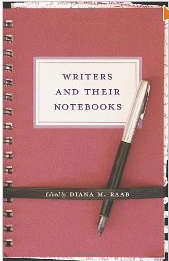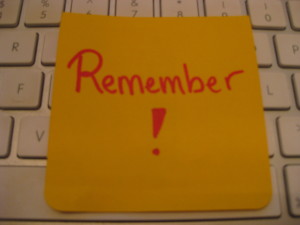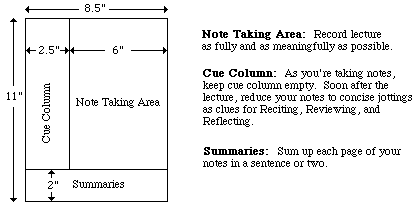5 Key Points for Organizing With Notebooks
A notebook is a notebook is a notebook. Or is it? The truth is, not all notebooks are created equally.

Notebooks seem like they should be pretty simple. At the heart, they are little books (or pads) of paper that allow us to take notes (or draw, or map). Of course, our notes may not be handwritten, so if our notes are digital, our notebooks must live in cyberspace, too. But there’s more to it than that.
Over the next few posts, we’re going to be looking at some new approaches to notebooks, making it a good time to review five noteworthy concepts related to organizing thoughts and information and making notetaking make sense. Bear in mind the following:
1) You can’t remember everything. The space in your brain is finite. It’s a common myth that most of us rarely use more than 10% of our brains. I’m not a neuroscientist, but I do know that our brains can’t maintain an unlimited amount of information and make it all equally accessible when and how we want it.
Simply put, you can’t think about things in-depth and with context if you’re constantly trying to remember to think of them.
Keeping a notebook doesn’t just enhance your memory; it sharpens your focus. When you merely listen to the world (whether the outside world or your own interior world), it’s easy to be passive. However, keeping notes turns listening into an active experience. The mere act of writing something forces you to put effort into comprehension.
Finally, once the general fact of something is written down (and temporarily stored), your brain can focus on analysis, processing and planning.
2) Loose notes don’t work. One of the ultimate, classic Paper Doll posts was Stay Far From Floozies: Avoiding the Loose Paper Trap. In organizing, we often talk about having a landing strip where we unload all the detritus of the day to ensure that phones get charged and keys remain accessible. (In the morning, the process is reversed and the landing strip becomes a launch pad, loaded with whatever essentials are needed to launch you out the door for a successful and organized day.)
If we skip the landing strip and just drop things wherever we let go of them, we’re dependent upon our eyes or memories for finding them again, slowing down the retrieval process. Having a notebook, one central location for incoming stimuli, is similarly a safer bet than letting notes “drop” on the backs of envelopes, the corners of napkins and the palm of your hand.
3) It’s not really about the notebook — it’s about you. As a professional organizer, I’ve found that the most significant reason a system works or does not, whether it’s for notetaking or calendaring or task management (or laundry or workflow or meal planning), has far less to do with the system used and far more to do with the user.
If an organizing system, or even the containers for your organizing system, do not fit your personal style, whether in terms of aesthetics, format or method of function, you’re going to find excuses to avoid using your system, and you’ll go back to whatever you used before, even if it failed you miserably.
(If going by gut instinct worked, we’d never seek outside help in the first place. Remember, if you always do what you’ve always done, you’ll always get what you always got!)
In Notions On Notebooks: Organize Your Paper Picks, we talked about how price and branding, binding, paper quality, lines, and color all determine whether a paper notebook format will be right for you. Reviewing that post will help you think about what notebook features will help you commit to a notetaking system.
4) The platform isn’t the same as the system. When we talk about notebooks, we tend to interchange the two, but they are very different. The platform is the physical (or digital) rendition of what tools we choose for organizing. At your house, you may store items in drawers, cabinets and lidded tubs, but that’s not an organizing system. Notebooks, like drawers, are containers. They serve a function for supporting an organizing system, but they are not the system, per se.
In the past, we’ve talked about a wide variety of notebook platforms, from environmentally-friendly notebooks (Green-Eyed But Not-So-Monstrous) to hybrid digital/paper notebooks (An Organized Hybrid: The Evernote Smart Notebook By Moleskine, From Paper to the Cloud: Ampad Shot Note) to adjustable notebooks (Presto, Change-o! Shape-shifting Organizing Products #2), and even waterproof notebooks (Paper Doll Writes Between the Raindrops: Waterproof Notebooks).
Whatever format or platform you use for a notebook, recognize that while the platform has to inspire your loyalty, it will only get you so far.
5) A notebook is only as good as the system you use for processing the information you put into it. Notebooks tend to exist for three disparate but sometimes interlocking purposes:
- Creating (journaling, sketching, designing) — What you put in these notebooks may not need to be tracked or managed. Just having a place to put your creations is often enough. However, if you are prolific, and retrieval of the product of your brilliance is an issue, you may want or need an indexing system for tracking what you’ve created.
This could be as simple as numbering your pages keeping a blank page at the front of your notebook for listing what you’ve designed or written. You might want to take a page (pardon the pun) out of philosopher John Locke’s approach to indexing commonplace books.
- Capturing (academic notes, business meeting notes, committee notes) — Once you capture essential information, you are generally asked to process it. The notes you take in your European history course may require you to capture fine detail regarding causes of wars or dates of battles so that you can memorize and regurgitate information. Conversely, notes captured in a client meeting might be the jumping off point for creating something new (an ad campaign, a solution to a problem, a product or service).
If you’re a student, to make sure you’ve got command of the subject, consider the Cornell Notetaking System (which is actually a system for learning and studying and not merely taking notes).
I was introduced to this process as a high schooler, long before I actually attended Cornell University, and it’s so useful, it’s really worthy of its own post. (Lifehacker has an excellent classic post on the Cornell system.)
For keeping up with business or other reading, you might prefer charting, outlining or mapping related concepts.
- Productivity (tasks) — If your notebook is designed to help you amass everything you need to do, rather than everything you need to know, you’ll need to find a workflow that makes sense for your life before you try to pick a snazzy notebook. A few systems that have enjoyed popularity in recent years include:
Bullet Journal — This method was covered in detail last year in Lifehacker’s The Bullet Journal Productivity Method Empowers Your Paper Notebook.
The AutoFocus System devised by time management expert Mark Forster. I’ve always thought my colleague Janine Adams, a Forster devotée, has done an excellent job explaining each iteration of the AutoFocus method. (The newest version of this system is called FinalVersion.)
So, I hope we’re clear that depending on memory or a series of fluttering scraps of paper is no way to master the information in your life. Notebooks can be excellent tools for organizing thoughts, but recognize that success depends on knowing yourself and your aesthetic deal-breakers, and employing information capturing and indexing systems that will keep you sticking to your system long into the future.






Follow Me